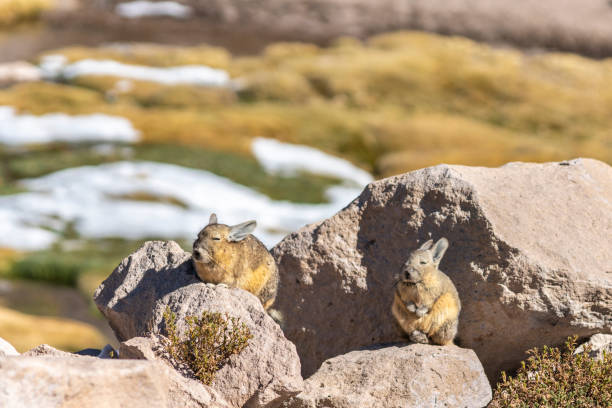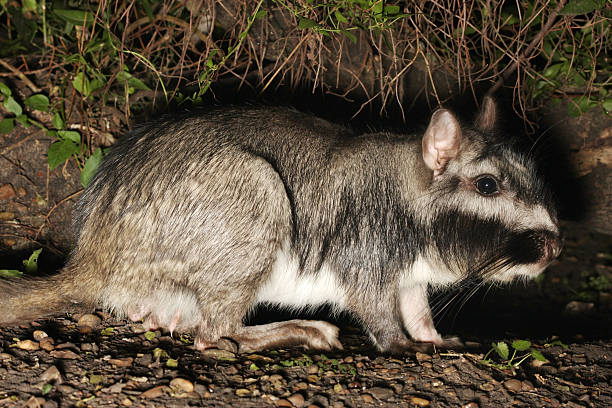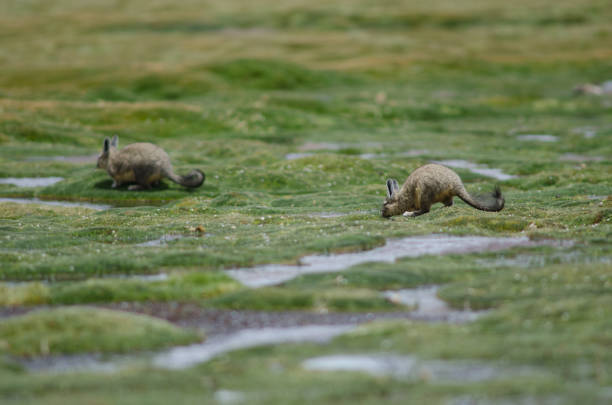Viscachas Unveiled: Exploring High-Altitude Wonders
This post contains affiliate links. This means I will make a commission at no extra cost to you should you click through and make a purchase. Read the full disclosure here.
In the sweeping landscapes of the South American highlands, a creature as enigmatic as it is adorable makes its presence known – the Viscacha. Resembling a cross between a rabbit and a guinea pig, Viscachas are a group of small rodents that have carved out a niche in some of the most extreme and challenging environments on Earth. With their distinct features and remarkable adaptations, these creatures have captured the fascination of biologists and nature enthusiasts alike.
In this blog post, we’ll embark on a journey to uncover the hidden world of Viscachas, diving into their unique characteristics, behaviors, and ecological significance. So, fasten your seatbelts as we explore the captivating realm of Viscachas and gain a newfound appreciation for the wonders of our planet’s diverse ecosystems.
Habitat and Distribution

Thriving in the Heights: Viscachas’ Chosen Realms
As we venture into the remote regions of the South American highlands, it becomes evident that Viscachas have adapted to some of the most extreme environments on the planet. These furry inhabitants have carved out a niche in the rocky terrains, steep slopes, and sparse vegetation of the Andes Mountains and their surrounding areas.
Andean Abodes
Viscachas primarily inhabit the alpine and montane ecosystems of the Andes, from Argentina and Chile in the south to Peru and Bolivia in the north. Their choice of habitat is not a matter of convenience; rather, it’s a testament to their extraordinary ability to survive in conditions that challenge even the hardiest of creatures.
Living on the Edge
Viscachas’ habitats are characterized by thin air, dramatic temperature fluctuations, and limited food sources. These high-altitude environments impose significant physiological and ecological demands on the animals that call them home. However, Viscachas have evolved a suite of adaptations that allow them to thrive in these seemingly inhospitable settings.
Ecological Harmony: Viscachas’ Role in the Ecosystem
While Viscachas may seem like small, inconspicuous rodents, their presence in the highlands plays a vital role in maintaining the balance of their ecosystems. By consuming grasses, leaves, and other plant matter, Viscachas occupy the role of primary consumers. In doing so, they help control vegetation growth and contribute to the cycling of nutrients within their habitat.
Connecting the Dots
The impacts of Viscachas’ foraging reverberate throughout the ecosystem. By influencing vegetation dynamics, they indirectly affect other species that rely on specific plants for food or shelter. Thus, these unassuming rodents are woven into the intricate web of interactions that sustains life in their unique and harsh environment.
Physical Features and Adaptations

Masters of Survival: Adapting to the Altitudes
The extreme conditions of the high-altitude Andean environments have shaped Viscachas into masterful survivors, equipped with a range of physical features and adaptations that enable them to thrive where others might falter.
Fur and Form

One of the most recognizable features of Viscachas is their dense, soft fur, which acts as an insulating layer against the cold temperatures of their habitats. Their fur comes in various shades, often blending with the surrounding rocky terrain to provide effective camouflage from predators.
Tail Tales

Perhaps the most distinctive attribute of Viscachas is their long and bushy tail. This unique tail serves multiple purposes, including thermoregulation. During cold nights, Viscachas wrap their tails around their bodies to conserve heat. Conversely, on warmer days, they stretch out their tails to dissipate excess heat, much like a radiator.
Oxygen Optimization

The thin air of high altitudes presents a challenge for many animals, but Viscachas have evolved mechanisms to cope with reduced oxygen levels. Their efficient respiratory systems allow them to extract more oxygen from each breath, ensuring that their bodies receive the vital supply of oxygen necessary for survival.
Water Wisdom
Water is a precious resource in these arid landscapes, and Viscachas have developed water-conserving adaptations. Their efficient kidneys enable them to concentrate urine, reducing water loss. Additionally, they obtain a significant portion of their water needs from the moisture present in their herbivorous diet.
Energy Economics
Surviving at high altitudes demands energy-efficient behaviors. Viscachas are known for their relatively slow movements, conserving energy as they navigate their challenging terrain. This deliberate pace also allows them to minimize the need for frequent foraging, which can be difficult in resource-scarce environments.
Nature’s Ingenious Design
The physical adaptations of Viscachas are a testament to the ingenuity of evolution. These creatures have honed their bodies to perfection, enabling them to thrive where few other animals could. Their unique fur, remarkable tail, efficient oxygen utilization, and water-conserving strategies highlight the interconnectedness between form and function.
Social Behavior and Communication

Society in Solitude: The Social Lives of Viscachas
While the high-altitude environments that Viscachas inhabit may seem isolated and desolate, these rodents have developed a rich social structure that enables them to thrive in their challenging surroundings.
Colonial Cohesion
Viscachas are known for their propensity to live in colonies, where individuals band together for protection, warmth, and social interaction. These colonies can range from a few individuals to several dozen, depending on the availability of resources and the specific habitat conditions.
Hierarchical Harmony
Within a colony, Viscachas establish a hierarchy that determines access to resources and mates. Dominant individuals enjoy certain privileges, such as prime nesting spots and first access to food. This hierarchical system helps minimize conflicts and maintain order within the colony.
Conversations Beyond Words: Viscachas’ Communication
Communication is essential for the survival and cohesion of any social group, and Viscachas have developed a repertoire of methods to convey information and maintain connections within their colonies.
Vocal Vibrations
Viscachas communicate through a variety of vocalizations, ranging from high-pitched chirps and whistles to softer, more melodic calls. These vocalizations serve various purposes, including alerting the colony to potential threats, signaling mating readiness, and maintaining group cohesion.
Body Language
Much like other social animals, Viscachas utilize body language to convey messages. They may raise their heads to assert dominance or flatten themselves against the ground to signal submission. These subtle cues help prevent unnecessary conflicts and maintain the social harmony of the colony.
Scent Marking
Scent plays a significant role in Viscachas’ communication. They mark their territories and pathways with scent glands located on their bodies, leaving behind olfactory cues that convey information about their identity, status, and presence. This marking helps establish boundaries and reduces aggression within the colony.
Beyond Survival: The Value of Social Bonds
The social behaviors and communication methods of Viscachas offer a glimpse into the interconnected lives of these creatures. By living in colonies and forming social bonds, Viscachas not only increase their chances of survival but also enrich the fabric of their unique ecosystem.
Burrow Architecture and Functions

Subterranean Sanctuaries: Viscachas’ Ingenious Burrow Systems
Beneath the rugged terrain of the South American highlands lies a hidden world – a labyrinth of tunnels and chambers meticulously crafted by the paws of Viscachas. These intricate burrow systems serve as not just shelters, but also fulfill an array of vital functions that enable Viscachas to thrive in their demanding environment.
Entrance Engineering
Viscachas are skilled diggers, excavating entrances to their burrows on the slopes of hills or beneath rocks. These entrances serve as discreet points of access and egress, allowing Viscachas to move in and out of their burrows while minimizing the risk of predation.
Chambers of Purpose
The burrows themselves are far from simple holes in the ground. Viscachas create a network of interconnected chambers, each designed for a specific purpose. These chambers include nesting areas for raising young, storage spaces for food, and even designated spots for waste disposal.
Safe Havens
The burrows provide Viscachas with protection from predators such as birds of prey, foxes, and wildcats. When danger approaches, Viscachas can quickly retreat into the safety of their underground fortresses, utilizing the intricate network of tunnels to evade capture.
Temperature Regulation
In a high-altitude environment, temperature fluctuations can be extreme. The burrows provide Viscachas with a stable microclimate, shielding them from the harsh weather conditions outside. This thermal insulation is particularly crucial during cold nights and scorching days.
Architects of the Earth
Viscachas’ burrow-building abilities showcase their remarkable adaptation to the unique challenges posed by their environment. By creating these subterranean habitats, Viscachas not only ensure their survival but also contribute to the overall ecological dynamics of their ecosystem. These burrows serve as microcosms of life, showcasing the ingenuity of nature’s architects and the astonishing ways in which creatures adapt to their surroundings.
Diet and Feeding Habits

Nourishing the Heights: Viscachas’ Herbivorous Lifestyle
In the unforgiving landscapes of the South American highlands, Viscachas have embraced a herbivorous diet as their ticket to survival. These small rodents play a vital role as primary consumers in their ecosystem, influencing plant growth dynamics and indirectly impacting the lives of various other species.
Plant-Based Palates
Viscachas are specialized herbivores, primarily feeding on grasses, leaves, and other plant matter. Their diet is well-suited to the available resources in their high-altitude habitats, where plant growth can be challenging due to harsh conditions.
Grazing Guardians
By consuming plant material, Viscachas participate in a delicate dance with the vegetation of their environment. Their grazing behavior helps control the growth of plants, preventing overgrowth and ensuring that other species dependent on these plants have access to resources.
Ecosystem Engineers
As primary consumers, Viscachas influence the flow of energy and nutrients through their ecosystem. Their feeding habits contribute to nutrient cycling, transferring energy from plants to higher trophic levels, such as predators that rely on Viscachas as a food source.
Balancing Act: Foraging in Harsh Landscapes
Foraging for food at high altitudes is no easy task, given the limited availability of plant resources and the challenges posed by the environment. Viscachas have adapted their foraging behavior to optimize their energy expenditure and ensure their survival.
Selective Foraging
Viscachas are selective in their choice of plants, often favoring species that provide the most nutritional value. This selective approach helps them make the most of the limited resources available to them.
Timing and Tactics
These rodents often forage during the cooler parts of the day to avoid the heat and conserve energy. Their deliberate foraging style and the ability to cover long distances in search of food contribute to their energy-efficient lifestyle.
Food Storage
Viscachas exhibit another interesting behavior: food caching. They store excess food in their burrows, creating stockpiles that can sustain them during times of scarcity. This strategy is especially important in their unpredictable and resource-scarce environment.
Guardians of the Grasslands
Viscachas’ herbivorous lifestyle not only reflects their adaptability but also underscores their role as important contributors to the high-altitude ecosystem. By controlling vegetation growth and facilitating nutrient cycling, these small rodents exert a profound influence on the dynamics of their habitat.
Threats and Conservation

Balancing on the Precipice: Threats to Viscacha Populations
While Viscachas have demonstrated their resilience and adaptability to the harsh conditions of the South American highlands, they are not immune to the threats posed by human activities and environmental changes. Several factors are putting pressure on Viscacha populations and their delicate ecosystems.
Habitat Loss
As human populations expand and agricultural activities encroach upon natural habitats, Viscachas are losing the spaces they rely on for survival. Deforestation and land conversion disrupt the balance of their ecosystems, leaving them with fewer suitable places to call home.
Climate Change
The already challenging conditions of high-altitude environments are being exacerbated by climate change. Rising temperatures and altered precipitation patterns can impact the availability of food and water resources, affecting Viscachas’ ability to thrive.
Predation
Introduced predators, such as domestic dogs and cats, can pose a significant threat to Viscacha populations. These predators may not have natural predators in the region, leading to increased predation on local wildlife, including Viscachas.
A Call to Preserve
As we recognize the challenges that Viscachas face, it becomes clear that their survival hinges on proactive conservation efforts. These unique rodents play an integral role in maintaining the health and balance of their ecosystems, and their decline could have cascading effects on other species and the environment as a whole.
Research and Awareness
Gathering more data on Viscachas’ populations, behaviors, and habitat requirements is essential for informed conservation efforts. Raising awareness about the importance of these creatures can garner support and resources for their protection.
Habitat Protection
Establishing protected areas and conserving the natural habitats of Viscachas is crucial. By preserving the environments in which they thrive, we ensure that future generations can continue to marvel at the intricacies of these unique rodents.
Mitigating Human Impact
Engaging with local communities to promote sustainable land use practices can reduce the impact of human activities on Viscacha habitats. Encouraging responsible tourism and development can help strike a balance between human needs and the needs of the ecosystem.

Embracing the Viscacha Legacy
The story of Viscachas serves as a reminder of the intricate connections that bind all living beings within an ecosystem. Their survival is not just a matter of individual significance but a testament to the delicate equilibrium that sustains life in the South American highlands. By championing their conservation, we honor the legacy of these unique rodents and contribute to the preservation of the world’s natural wonders.
As we conclude this exploration into the world of Viscachas, let us remember that the choices we make today can shape the fate of these remarkable creatures and the ecosystems they call home. It’s a call to action for us all to play a part in safeguarding the diversity and beauty of our planet’s landscapes.







